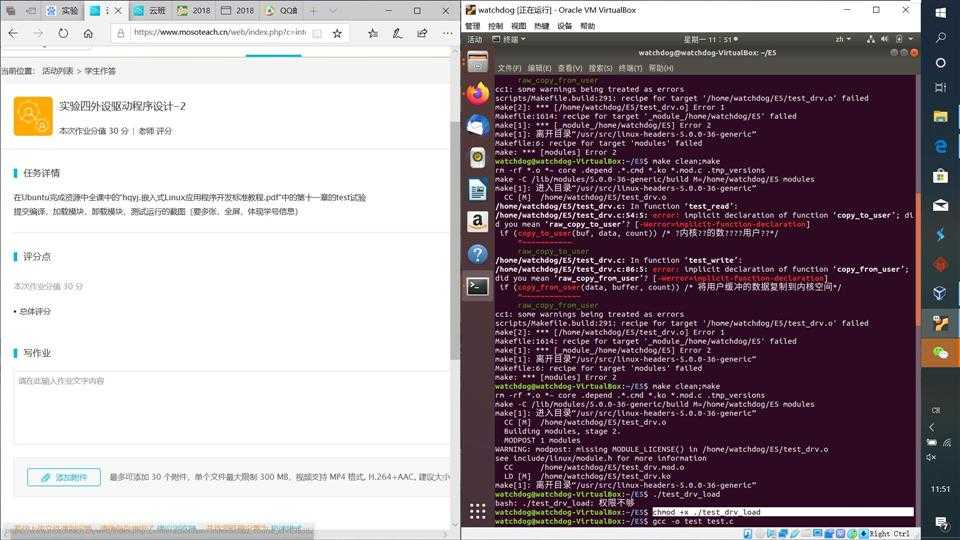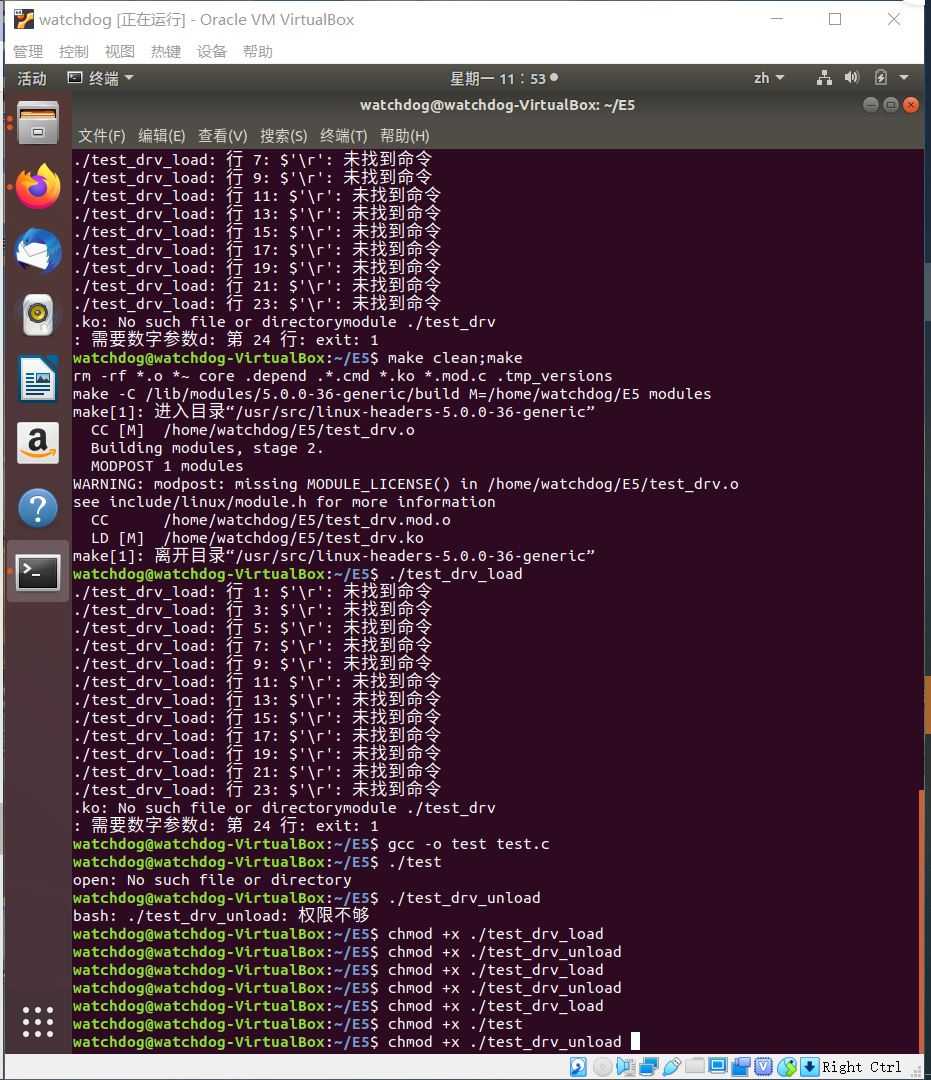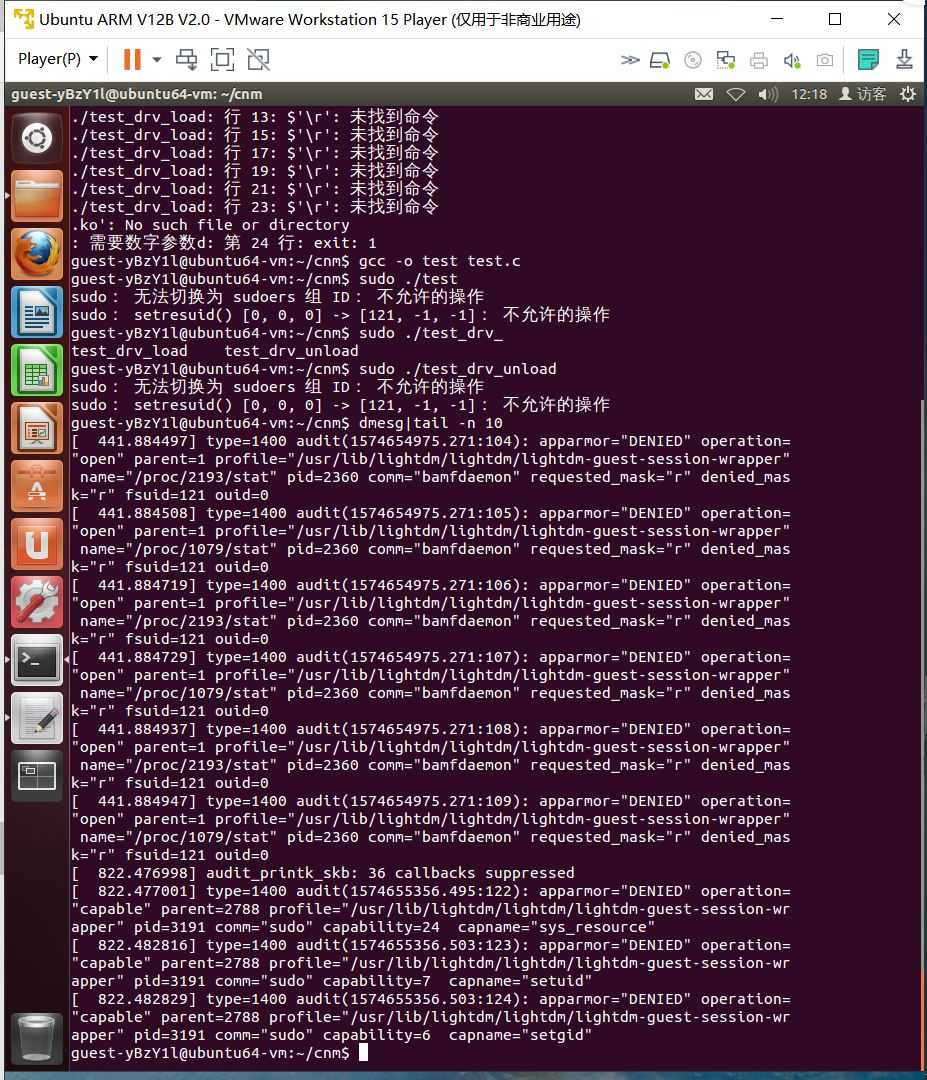2019-2020-1 20175311 20175324 20175330 实验四 外设驱动程序设计
Posted wcqy
tags:
篇首语:本文由小常识网(cha138.com)小编为大家整理,主要介绍了2019-2020-1 20175311 20175324 20175330 实验四 外设驱动程序设计相关的知识,希望对你有一定的参考价值。
一、实验目的
- 编写最简单的字符驱动程序
- 实现简单的读写功能,并列出常用格式的
Makefile以及驱动的加载和卸载脚本 - 实现简单的读写功能,并列出常用格式的Makefile以及驱动的加载和卸载脚本
二、实验内容及步骤
1、任务一
- 任务详情
- 学习资源中全课中的“hqyj.嵌入式Linux应用程序开发标准教程.pdf”中的第十一章
- 提交康奈尔笔记的照片(可以多张)
- 笔记

2、任务二
- 任务详情
- 在Ubuntu完成资源中全课中的“hqyj.嵌入式Linux应用程序开发标准教程.pdf”中的第十一章的test试验
- 提交编译,加载模块,卸载模块,测试运行的截图(要多张,全屏,体现学号信息)
- 实验步骤
- 在VMware虚拟机中创建文件夹
- 将第十一章中关于字符设备的
test实验中代码:test_drv.c、test.c、Makefile、test_drv_load、test_drv_unload敲入并保存在文件夹内 - 要注意在
Makefile中命令换行要用Tab键进行缩进 - 实验代码
Makefile
ifeq ($(KERNELRELEASE),) KERNELDIR ?= /lib/modules/$(shell uname -r)/build PWD := $(shell pwd) modules: $(MAKE) -C $(KERNELDIR) M=$(PWD) modules modules_install: $(MAKE) -C $(KERNELDIR) M=$(PWD) modules_install clean: rm -rf *.o *~ core .depend .*.cmd *.ko *.mod.c .tmp_versions .PHONY: modules modules_install clean else obj-m := test_drv.o endif
test.c
#include <stdio.h> #include <stdlib.h> #include <string.h> #include <sys/stat.h> #include <sys/types.h> #include <unistd.h> #include <fcntl.h> #define TEST_DEVICE_FILENAME "/dev/stdout" #define BUFF_SZ 1024 int main() { int fd,nwrite,nread; char buff[BUFF_SZ]; fd = open(TEST_DEVICE_FILENAME, O_RDWR); if(fd<0) { perror("open"); exit(1); } do { printf("Input some words to kernel(enter ‘quit‘ to exit):"); memset(buff,0,BUFF_SZ); if(fgets(buff,BUFF_SZ,stdin) == NULL) { perror("fgets"); break; } buff[strlen(buff) - 1] = ‘�‘; if(write(fd,buff,strlen(buff)) < 0) { perror("write"); break; } if(read(fd,buff,BUFF_SZ) < 0) { perror("read"); break; } else { printf("The read string is from kernel:%s ",buff); } } while(strncmp(buff,"quit",4)); close(fd); exit(0); }
test_drv.c
#include <linux/module.h> #include <linux/init.h> #include <linux/fs.h> #include <linux/kernel.h> #include <linux/slab.h> #include <linux/types.h> #include <linux/errno.h> #include <linux/cdev.h> #include <asm/uaccess.h> #define TEST_DEVICE_NAME "test_dev" #define BUFF_SZ 1024 /*全局变量*/ static struct cdev test_dev; unsigned int major =0; static char *data = NULL; /*读函数*/ static ssize_t test_read(struct file *file, char *buf, size_t count, loff_t *f_pos) { int len; if (count < 0 ) { return -EINVAL; } len = strlen(data); count = (len > count)?count:len; if (copy_to_user(buf, data, count)) /* ?内核??的数????用户??*/ { return -EFAULT; } return count; } /*写函数*/ static ssize_t test_write(struct file *file, const char *buffer, size_t count, loff_t *f_pos) { if(count < 0) { return -EINVAL; } memset(data, 0, BUFF_SZ); count = (BUFF_SZ > count)?count:BUFF_SZ; if (copy_from_user(data, buffer, count)) /* 将用户缓冲的数据复制到内核空间*/ { return -EFAULT; } return count; } /*打开函数*/ static int test_open(struct inode *inode, struct file *file) { printk("This is open operation "); /* 分配并初始化缓冲区*/ data = (char*)kmalloc(sizeof(char) * BUFF_SZ, GFP_KERNEL); if (!data) { return -ENOMEM; } memset(data, 0, BUFF_SZ); return 0; } /*关闭函数*/ static int test_release(struct inode *inode,struct file *file) { printk("This is release operation "); if (data) { kfree(data); /* 释放缓冲区*/ data = NULL; /* 防止出现野指针*/ } return 0; } /* 创建、初始化字符设备,并且注册到系统*/ static void test_setup_cdev(struct cdev *dev, int minor, struct file_operations *fops) { int err, devno = MKDEV(major, minor); cdev_init(dev, fops); dev->owner = THIS_MODULE; dev->ops = fops; err = cdev_add (dev, devno, 1); if (err) { printk (KERN_NOTICE "Error %d adding test %d", err, minor); } } /* 虚拟设备的 file_operations 结构 */ static struct file_operations test_fops = { .owner = THIS_MODULE, .read = test_read, .write = test_write, .open = test_open, .release = test_release, }; /*模块注册入口*/ int init_module(void) { int result; dev_t dev = MKDEV(major, 0); if (major) {/* 静态注册一个设备,设备号先前指定好,并设定设备名,用cat /proc/devices 来查看 */ result = register_chrdev_region(dev, 1, TEST_DEVICE_NAME); } else { result = alloc_chrdev_region(&dev, 0, 1, TEST_DEVICE_NAME); } if (result < 0) { printk(KERN_WARNING "Test device: unable to get major %d ", major); return result; } test_setup_cdev(&test_dev, 0, &test_fops); printk("The major of the test device is %d ", major); return 0; } /*卸载模块*/ void cleanup_module(void) { cdev_del(&test_dev); unregister_chrdev_region(MKDEV(major, 0), 1); printk("Test device uninstalled "); }
-
实验结果及截图
- 编译并加载驱动模块
- 编译:
make clean;make - 给脚本文件增加可执行权限:
chmod +x ./test_drv_load - 以管理员身份运行加载脚本:
sudo ./test_drv_load - 查看驱动程序编号:
cat devices
- 编译并运行测试程序
- 编译:
gcc -o test test.c - 运行:
./test - 根据提示输入信息
- 编译:
- 卸载驱动程序
- 以管理员身份运行加载脚本:
sudo ./test_drv_unload - 查看驱动程序编号:
cat devices 

- 以管理员身份运行加载脚本:


三、实验过程中遇到的问题及解决办法
问题 :经常出现权限不足的情况,每次都得添加权限才行。
以上是关于2019-2020-1 20175311 20175324 20175330 实验四 外设驱动程序设计的主要内容,如果未能解决你的问题,请参考以下文章
2019-2020-1 20175311 20175324 20175330 实验四 外设驱动程序设计
2019-2020-1 20175311 《信息安全系统设计基础》 ls学习实现与改进
2019-2020-2 网络对抗技术 20175311胡济栋 Exp4 恶意代码分析
2019-2020-2 网络对抗技术 20175311胡济栋 Exp7 网络欺诈防范
